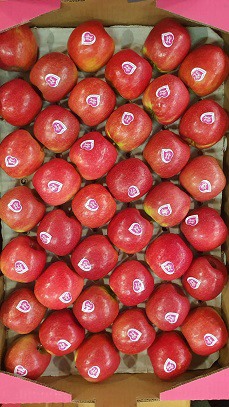 The Western Cape is slowly emerging from winter – more snow fell this week and rain is again predicted for the weekend – but as orchards come into flower, producers and pollinators would appreciate warmer temperatures.
The Western Cape is slowly emerging from winter – more snow fell this week and rain is again predicted for the weekend – but as orchards come into flower, producers and pollinators would appreciate warmer temperatures.
Right: Pink Lady apples packed in Ceres
”It’s been a few years in a row now that spring remains cold, but at least our dams are full,” says CoreFruit’s head of pome fruit Thomas Mouton.
Last November hail damaged the apple and pear crops in the Ceres area, where most of the pomefruit that CoreFruit markets, is grown.
“The majority of apple and pear producers didn’t have big crops this year because of the hail – its intensity and wide distribution was unprecedented. On average, price points have definitely been better than last year because of primarily three reasons: the pressure on supply – not only in South Africa but throughout the entire Southern Hemisphere. Secondly the cost chain, of which sea freight is the biggest component, has improved since last year when logistics costs peaked. And the third reason is the exchange rate.”
The South African Rand has significantly weakened and today trades at R19.22 to US$1.
Closure of Taiwanese market hurtsDespite the reduction in volumes, CoreFruit is still packing apples and pears from CA rooms and they’ll see the year through.
“It was our first full season of sending pears to China. There were positive price points at times, but it’s a new market where we learned a lot about consumer requirements regarding cultivar and count. The addition of China is very positive for our industry but it’s not a silver bullet. One always needs to ensure that the quality is right and that it is placed on the market at the right period.”
Thomas notes that demand from India was higher (it wasn’t always possible to meet demand due to lower available supply) but the closure of Taiwan for South African apples for phytosanitary reasons, was a big loss, especially on Fuji apples.
Apples are, by far, the most consumed fruit in South Africa, with per capita consumption is 4.83 kg apples per person.
“One does hope it could increase but the reality is that fruit remains a luxury item and in our experience when times are tough, people cut on fruit in their shopping basket.”
That said, he adds, the South African market didn’t fare badly, largely because supply was constrained and average prices are higher as a result.
“Higher apple prices have meant better returns on farms, and that is good. The cost of the supply chain remains incredibly high. This week’s rise in diesel costs is one example, which has a big impact on the cost of farming, packing and cooling, especially during loadshedding,” he says. For more information:
For more information:
Thomas Mouton
CoreFruit
Tel: +27 21 863 6300
Email: [email protected]
http://www.corefruit.com/










